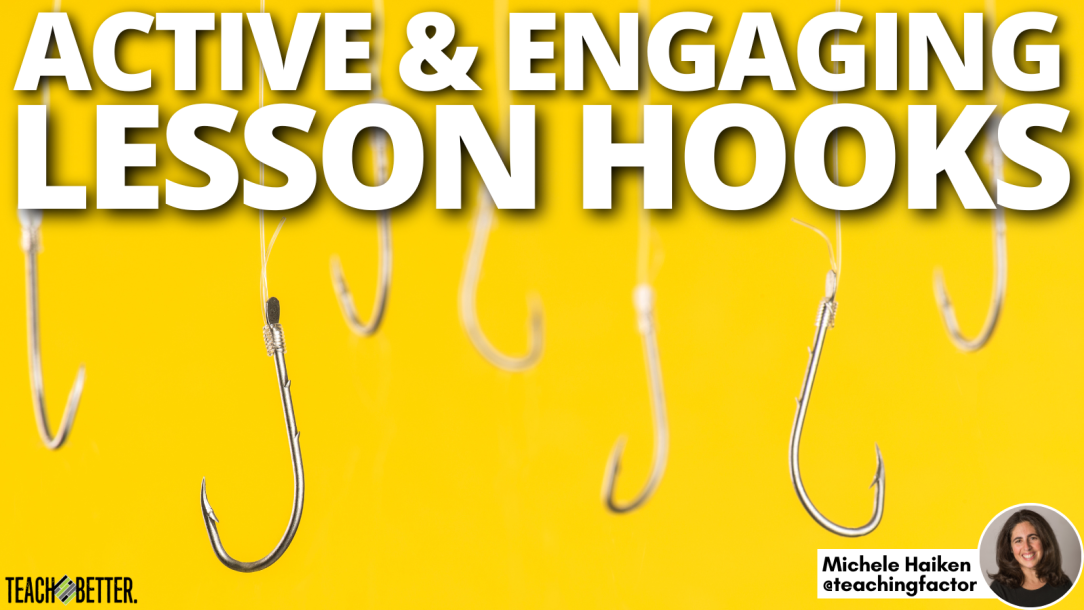TL;DR:
- The first rule to lesson planning is to start with a hook. These should be engaging to motivate all learners.
- There are 3 ways to hook your students: (1) Legos and Play-Doh to showcase thinking and ideas. (2) Gallery walks to record thoughts and ideas to share with others. (3) Four Corner Debate to organize students into groups based on opinions.
Active & Engaging Lesson Hooks
The bell rings. Students are all sitting in their seats. Their attention is at the front of the room where a PowerPoint or Google slide deck is displayed for all to see. You are ready to give your lesson. Is this the scene in Ferris Buller’s Day Off where Ben Stein is the economics teacher throwing out questions to students looking at him with blank stares while his voice drools out, “Anyone, anyone?” Then we see various close up shots of aloof students checked out. There’s even one extreme close up that shows a student drooling while sleeping with his head down on his desk.
Lesson Planning Rule #1: Start With a Hook
Just like the hook in a movie or piece of literature, the opening hook of your lesson needs to draw students in right at the beginning. Consider adding an element of mystery, intrigue, and fun into this opening portion of your lesson. The hook or warm-up is where students are invited into the lesson, access background knowledge, and learn the significance of the day’s lesson.
Hooks should be ENGAGING to support all learners. This is a crucial moment to engage and motivate students. Consider visual or graphic hooks, technology-based hooks, and interactive experiences. Hooks and warm-ups can be collaborative and require active learners.
So, before students even take a seat, hook them while they are standing. Below are three different ways to hook your students!
Hooks should be ENGAGING to support all learners. This is a crucial moment to engage and motivate students. Click To TweetLegos & Play-Doh
Pull out the Legos and/or Play-Doh and have students work in small groups of 3-4 to sculpt an image or prototype. Set a timer and students work together to showcase their thinking and ideas. After time runs out, take a gallery walk with the whole class around the room to see student ideas, extend thinking, and make connections to the day’s lesson.
Gallery Walks
Hang chart paper around the room and provide all students with a marker jot down their ideas. Post a question, image, or text excerpt on or next to the chart paper for students to read, ponder, and respond to. For example, when I was teaching an all-class read of George Orwell’s Animal Farm, six large posters were taped around the walls of the classroom. Each chart paper was labeled with a specific chapter number. Students had to go around the room and write a headline to summarize the key events in that chapter. This is a thinking protocol I adapted from Harvard’s Project Zero Headline Protocol.
[scroll down to keep reading]Four Corner Debate
Get students thinking and talking with a Four Corner Debate. Pose a statement to the class and then ask students to show their position. You will need to prepare the room and label the four corners of the classroom with signs that read: “Strongly Agree,” “Agree,” “Disagree,” and “Strongly Disagree.” Students then stand in the corner based on their response to the statement. Once in that corner, students can talk with the students who have similar positions sharing insights and commonalities. After a few minutes of small group discussion, open up the conversation to the whole class for each group to share their reasoning and thinking.
Peter Liljedahl writes in his book, Building Thinking Classrooms in Mathematics: 14 Teaching Practices for Enhancing Learning (Corwin, 2021), “have the students standing and working on vertical non-permanent surfaces (VNPSs) such as whiteboards, blackboards, or windows…had a massive impact on transforming previously passive learning spaces into active thinking spaces where students think, and keep thinking, for upwards of 60 minutes.” This means that standing up is key for active learning no matter the content area.
The first few minutes of your lesson set the tone for the rest of the class. So why not make it engaging and active?
About Michele Haiken
Michele Haiken, Ed.D is an educator, author, and blogger. She has been teaching for more than twenty four years as a middle school English teacher and an adjunct professor in New York. Michele is the co-author of the forthcoming book Creative SEL: Using Hands-on Projects to Boost Social Emotional Learning (ISTE, 2023) and author of New Realms for Writing (ISTE, 2019), Personalized Reading (ISTE, 2018), and editor of Gamify Literacy (ISTE, 2017). Michele is passionate about empowering 21st Century learners, educational technology and literacy so everyone can reach excellence. Read more on her blog theteachingfactor.com and connect with Michele on Instagram @teaching_factor and Twitter @teachingfactor.




